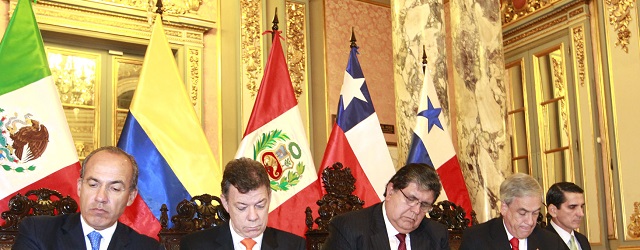Latin America’s most dynamic and open economic group, the Pacific Alliance, is holding a summit this week in Cali (Colombia) that is likely to consolidate their integration and, very probably, will incorporate two new partners. Its four founding members, Mexico, Chile, Peru and Colombia have already agreed on free citizen movement and are signing to liberalize 90% of their trade. For Spain, this meeting is the platform to access Latin America and Asia, the two fastest growing parts of the planet.
Chili, Peru, Mexico and Colombia representatives will be joined by Spain, Costa Rica, Panama, Guatemala and Canada’s. Australia, Japan, New Zealand and Uruguay will also send their delegates. Paraguay and Portugal will probably be there as observers, as well as France, Honduras and El Salvador. The USA, Italy, Indonesia, South Korea and China have made clear they are really interested as well.
Central American tigers Costa Rica and Panama, observers since the Pacific Alliance started, are expected to become full members. Thus, the group will have a total of six partners, surpassing older blocs such as Mercosur, CAN, or ALBA in effectiveness and force to the astonishment of Brazil, which fears losing influence in the area as well as in its relationship with China and the Pacific area.
What can we expect from the meeting? Probably specific agreements for promoting investment, student exchanges and more immigration flexibility. SMEs, which account for 96-98% of Latin America’s business sector, generating 60-62% of employment and contributing to 40-45% of GDP are seeking greater access to world markets, will have a major role.
Spain wants in
Spain has not officially announced date yet to request its full partner but it could happen before the end of this year. The Pacific Alliance is a gateway to Asian markets, an area that so far has been far from the Spanish economic and commercial influence area. Madrid is aware of the region’s importance for exports and investment in times of crisis.
Other experts point out that the Pacific Alliance and Mercosur are difficult to match since they follow different economic models: the Alliance’s members have FTA with the US and other foreign countries, whereas Mercosur is focused on custom integration among Latin American countries and the difficulties of Argentina and Brazil protectionism.
Some analysts consider that the Pacific Alliance could become “the new Brazil” and replace it as the best option for foreign investors who want to enter the Latin American market.
*Read the original article here.






Be the first to comment on "Investors, Latin America’s Pacific Alliance is here to stay"